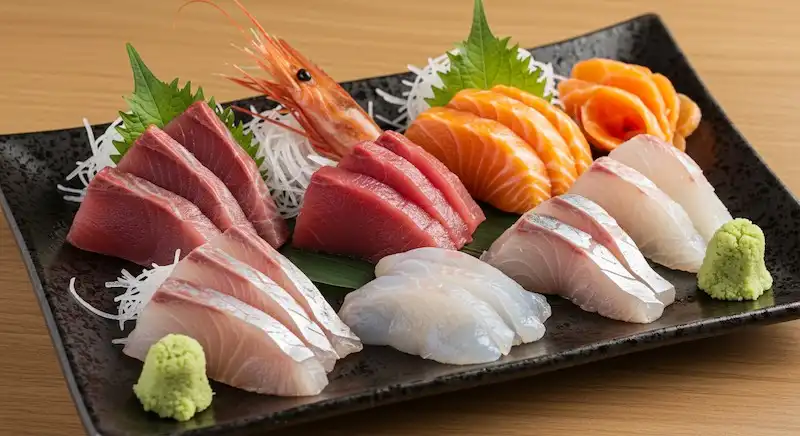Why are Japanese Women so Slim?
Have you ever wondered why Japanese women often seem to maintain a slim figure?
It’s a question many people ask, and while genetics might play a small role, the real secret lies in the Japanese diet.
Let’s dive into the fascinating world of Japanese food culture and discover the secrets of beauty and their healthnd beauty!
Table of Contents
The Bounty of the Sea: Fish and Seafood
Japan, as an island nation, has a deep-rooted food culture centered around the ocean.
Fish and seafood are staples in the Japanese diet, appearing on the table in countless delicious forms — from fresh sashimi and grilled fish to simmered dishes.
Compared to many Western diets, Japanese cuisine emphasizes fish as a primary protein source.

Oily fish like sardines, mackerel, saury, and horse mackerel are rich in DHA and EPA, omega-3 fatty acids known for promoting brain health and smooth blood flow.
They are also excellent sources of vitamin D for strong bones and taurine for energy.
White fish such as sea bream, flounder, cod, and sole offer high-quality protein for building lean muscle and vitamin D as well.
Red fish like tuna, bonito, and Japanese amberjack are packed with iron to prevent anemia and various B vitamins for energy metabolism, in addition to protein.
And let’s not forget shellfish and crustaceans like clams, oysters, scallops, shrimp, and crab, loaded with minerals like zinc and taurine, and beauty-enhancing astaxanthin in shrimp and crab.
Reasons to recommend fish over meat: National Health Insurance Association
Vegetables and Seaweed: Building Blocks of Beauty and Wellness
A colorful array of vegetables and seaweeds graces the Japanese dining table.
These plant-based treasures are packed with essential vitamins, minerals, and fiber crucial for maintaining health and beauty from the inside out.

Green and yellow vegetables such as spinach, Japanese mustard spinach (komatsuna), pumpkin, carrots, and green peppers are bursting with beta-carotene (converted to vitamin A in the body) for healthy skin, vitamin C for immunity, vitamin K, and folic acid.
Light-colored vegetables like cabbage, Japanese radish (daikon), Chinese cabbage (hakusai), cucumber, and eggplant are good sources of vitamin C, potassium, and fiber, while being low in calories and hydrating.
Root vegetables such as burdock root (gobo), lotus root (renkon), sweet potato, potato, and taro are rich in fiber, potassium, and vitamin C (especially in potatoes and sweet potatoes), and are known for their warming properties.
Seaweed also plays a vital role in the Japanese diet.
Wakame seaweed is a great source of iodine (essential for thyroid function and metabolism), calcium, magnesium, fiber, and fucoidan. Kombu seaweed is also rich in iodine, as well as calcium, potassium, fiber, and alginic acid.
Nori seaweed is unique in being a plant-based source of vitamin B12, and is also packed with protein, fiber, iron, and taurine.
Mozuku seaweed is low in calories and high in fiber (especially fucoidan) and minerals.
* Japanese people eat seaweed raw, but it seems that some Westerners cannot digest seaweed.
Fermented Foods: Cultivating Beauty from Within
Fermented foods, gaining popularity worldwide, are deeply rooted in Japanese food culture.
These foods, created through the magic of microorganisms, offer unique flavors and enhanced nutritional value, benefiting both beauty and health.

Yogurt, a breakfast staple, is packed with lactobacillus bacteria, promoting a healthy gut environment, aiding digestion, and contributing to beautiful skin.
Natto, fermented soybeans, is rich in natto bacteria for gut health and nattokinase, an enzyme known for its potential blood-thinning effects. Miso, a fermented soybean paste, is made with koji mold and yeast, offering gut-friendly benefits and beauty-enhancing components like soy isoflavones.
Pickles, especially nukazuke (rice bran pickles) and kimchi (though Korean in origin, widely enjoyed in Japan), are rich in plant-based lactic acid bacteria, promoting gut health.
These fermented foods contribute to a balanced gut flora by increasing beneficial bacteria and suppressing harmful ones.
A healthy gut is linked to improved digestion, nutrient absorption, boosted immunity, clearer skin, and even weight management.
Tips for Incorporating Japanese Dietary Habits
Inspired by the secrets of the Japanese diet?
You don’t need to completely overhaul your eating habits overnight.
Start with small, manageable steps to incorporate these beauty and health-boosting elements into your daily life.
Here are some easy tips to get started
- Swap meat for fish a few times a week.
Try grilled fish, sashimi, or fish-based set meals when dining out. - Add a side of vegetables to every meal.
Utilize pre-cut vegetables or frozen veggies for convenience. - Include yogurt in your breakfast routine.
Top with fruits and granola for a delicious and satisfying start to the day. - Incorporate one fermented food daily, such as miso soup, natto, or pickles.
Pack them for lunch or add them to your dinner. - Drink green tea instead of coffee or cola.
Green tea contains catechins and vitamins, making it healthier than sugary drinks.
- If you’d like to learn more about Matcha, please check out this article.
By gradually integrating these elements of the Japanese diet, you can embark on your journey towards a healthier and more beautiful you!
The secret of beauty and healthin japan
The Japanese diet, rich in seafood, vegetables, seaweed, and fermented foods, offers a holistic approach to beauty and health.
It’s not just about dieting; it’s about embracing a sustainable lifestyle that nourishes you from the inside out.
While diet is key, remember that overall wellness also includes regular exercise, sufficient sleep, and stress management.
By incorporating the wisdom of the Japanese diet into your life, you can unlock the secrets to a slimmer, healthier, and more radiant you!










Leave a Reply